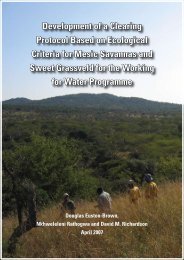Metsi Consultants - DWA Home Page
Metsi Consultants - DWA Home Page
Metsi Consultants - DWA Home Page
You also want an ePaper? Increase the reach of your titles
YUMPU automatically turns print PDFs into web optimized ePapers that Google loves.
Mitigation of Flow-Related Impacts<br />
METSI CONSULTANTS: SUMMARY OF MAIN FINDINGS FOR PHASE 1 DEVELOPMENT<br />
"Mitigation" refers to changes to project design, operations and/or project area management to reduce levels of<br />
impact and/or resource losses. The most practical form of mitigation will be the release of additional water (over<br />
and above Treaty-specified releases) to reduce levels of impact. The best achievable results will be those<br />
described under the Design Limitation Scenario, which seeks maximum use of available outflow capacities in the<br />
LHWP structures. Reductions in resource losses to wetbank vegetation (habitat for medicinal and wild food<br />
plants), river sand (construction), fish (food and livelihood) and fuelwood could be achieved through releases of<br />
flows totalling more than 100 million m 3 (MCM) per year, but significant residual losses would remain in all cases<br />
except wetbank vegetation. Public health risks for gastrointestinal, skin and eye diseases would be reduced but<br />
would remain severe in the lower Malibamats’o River and moderate in the lower Senqunyane River.<br />
Human and animal health risks would be better mitigated through specific programmes of sanitation, water<br />
supply, immunization, education and extension.<br />
Compensation for Flow-Related Impacts<br />
“Compensation” refers to cash, goods or services offered to replace resources that are unavoidably lost or<br />
activities that are impeded as a result of project development and implementation. Under the Treaty Scenario<br />
compensation will likely have to be provided to the households living along the lower Matsoku, Malibamats’o and<br />
Senqunyane rivers (IFR reaches 1,2,3 and 7) where biophysical impacts are predicted to be severe to critically<br />
severe. The need for compensation further down the system will have to be determined by monitoring of resource<br />
availability and reduction (if any) over time.<br />
Fuelwood and wild-harvested timber comprise the biggest resource loss to be compensated. Various forms of<br />
community-based forestry programmes are applicable as a means to supply woody fuel and timber; similar<br />
programmes have been applied elsewhere in Lesotho with only limited success. Supply of fossil fuels (paraffin)<br />
as a replacement is an option. Compensation for lost fish resources is best approached as a food replacement<br />
issue through horticultural and animal husbandry programmes since replacement of fish into flow-depleted and<br />
obstructed rivers will be expensive and minimally effective. Replacement of biological resources taken from<br />
riverine vegetation (food plants, medicinal herbs) will be technically and socially very difficult and expensive.<br />
Monitoring Programmes<br />
Two types of monitoring will be required – that related to IFRs (described further in the report body) and that<br />
related to mitigation and compensation programmes (dealt with in separate reports).<br />
IFR monitoring should be implemented to confirm actual amounts and seasonality of agreed flow releases, verify<br />
if the objectives of flow releases are being achieved, and guide adjustments of IFRs and/or objectives (adaptive<br />
management). Monitoring would best be undertaken at the already-established IFR sites, where baseline<br />
hydrological and biophysical data exist.<br />
Report No 678-F-001 viii

















